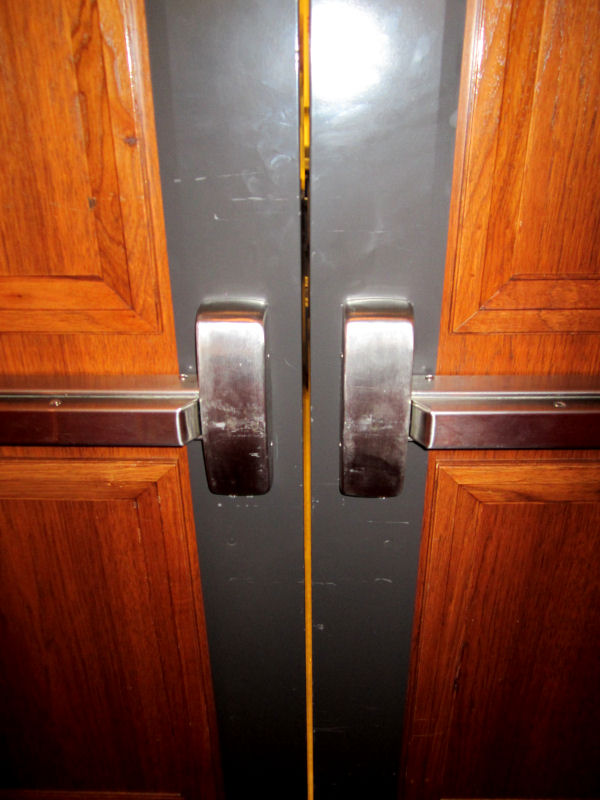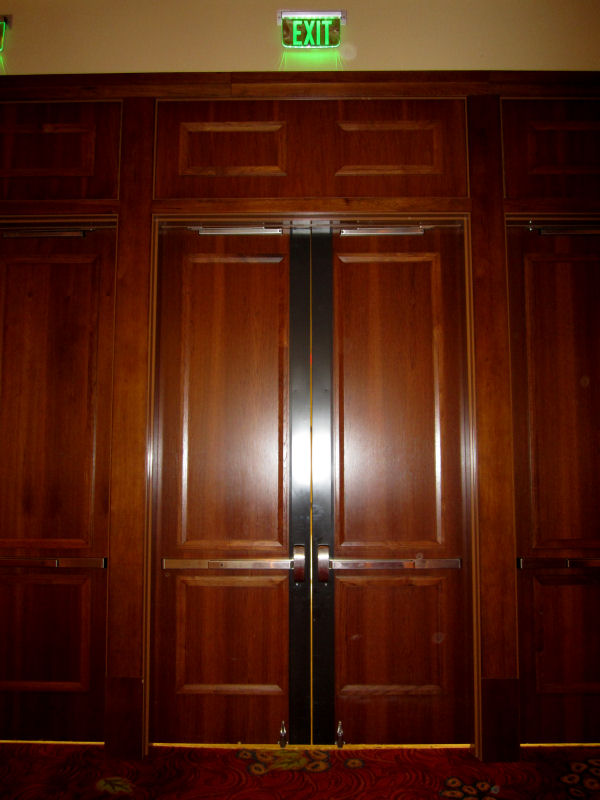Even though I risked being called a weirdo by my colleagues, I couldn’t pass up the opportunity to try to learn more about the 5″ wide edge channels that are sometimes required on fire-rated wood doors with concealed vertical rod exit devices. When these channels show up on the jobsite without warning, architects tend to be less than pleased. The interesting thing about these doors is that although they have the channels and fire exit hardware, there are no visible labels on the doors or frames. It’s possible that the door label is on top, although the concealed closer channels take up most of the real estate up there. We explored ways to check the top of these super-tall doors, but it will have to remain a mystery unless we can sweet-talk our way onto the lift they use to change the lightbulbs.
So, back to my question…some combinations of door manufacturer, rating, and concealed vertical rod exit device manufacturer require the channels, others don’t. I’d love to compile some sort of matrix to show these combinations, but the information is hard to find.
I found a VT Industries chart here, which notes on the 20-minute pages that doors with concealed vertical rod devices require the 5″ channel, but there isn’t a similar note on the 45-, 60-, and 90-minute pages.
I also found an Eggers bulletin here, stating that the edge channels are not required for Category A pairs up to 8′ x 8′
Here’s one from Algoma Hardwoods, which seems to show the 5″ edge channel for all ratings and all exit devices except one.
If you have any information from other manufacturers, or modifications to the information above, let me know!
As I said yesterday, there are a lot of beautiful design details here at the hotel and conference center. I love these light fixtures. To get an idea of scale (think HUGE)…the wood panels look to be about 4′ x 8′.
P.S. For those of you who noticed the plunger stops and oversized undercuts, two brownie points for you. 🙂
You need to login or register to bookmark/favorite this content.










Lori; Regarding edge channels on wood doors with concealed latches. I would require them in my facility reguardless of labeling. After prep there is not enough of the door left to sustain any kind of impact…especially force against the latches, without structural damage to the door. Love your postings..Thanx Dave
Hi Dave –
Would you typically require 5″ wide edge channels, or standard edge guards (if the door manufacturer would do it)?
– Lori
Lori, I thought the metal channels were necessary when you use CVR exit devices on fire rated wood doors. These doors can’t be rated because of the plunger stop that is used as a hold open, plus the large under cut, which is governed by NFPA 80. If they aren’t rated, then why the need for the metal channels on the wood doors with the CVR exits? Is it because of the height of the doors? Also, with that excessive undercut, these must be less-bottom-rod devices.
Now you know why I was so confused! I went through the exact same thought process!
– Lori
Lori,
I did some investigation last month on this topic. Of all the wood door manufacturers we work with on a regular basis, Eggers is the only one who will do metal-free edges on fire-rated doors.
VT is the only one who requires metal edges even on their non-fire-rated doors.
I am sure there are probably others out there who might fall in one of those categories, but they wouldn’t be our usual suppliers.
Thanks Joe! That’s great information!
Do we need to chip in and buy you needed inspection equipment??
http://www.shopping.com/See-All-Industries-Standard-12-inch-x-12-inch-Flat-Under-Carriage-Inspection-Mirror-Indoor/info
I was wishing that I had my telescoping mirror but I didn’t pack it!
I think I see hex key dogging on the picture of the pair. Therefore, and they better be, non-rated doors! I suspect the channels are due to the height. I think we have a matrix around here that we use but I’m not sure it’s up to date. I’ll check.
Hi Lee –
That device has a little plastic plug that fills the hole when the device does not have dogging, so what you’re seeing is that plug. There are also 7′ doors in this facility with the channels. I’d love to see your matrix and maybe help update it.
– Lori
If my memory serves me correct one solution is use Adams Rite 3900 CVR devices, these are top rod only latching devices and number of manufacturers can build these doors without metal edges of any kind. I did a Marriott ball room with Mohawk Doors and Adams Rite devices. The key is their latch system. Again I thnk it comes down to the individual door manufacturers testing though.
Hi Travis –
Yes, Algoma’s information shows that they don’t require channels with that device. I’m not sure about the other manufacturers.
– Lori
Regarding the wood doors – are these stile and rail panel doors or “applied” panels. Haven’t seen alot of rated s&r panel doors. I’m bettting you checked the exit device for UL labels. Not that anyone would put a rated device on a non-rated door. And I always put kick plates on wood doors with closers.
Hi Jack –
I think they are stile and rail doors but I will take another look tomorrow. The exit device is UL labeled fire exit hardware. I have occasionally seen a rated device on a non-rated door but not on an application like this. I agree with you on the kick plates.
– Lori
They are flush wood doors with applied trim. The sight of the channels just scared me away from spec’g this combo…esp. since I can’t control the door manu. :-S. Thanks for the timely post.
CVR on wood doors are not my favorite because I think they weaken the door, but sometimes the architect won’t take no for an answer. I wouldn’t steer clear of concealed vertical rods on wood doors completely…I would just make the architect aware of the issue.
The doors look like they have applied moulding. If you look at the grain pattern it looks like the veneers all run continuously from top to bottom.
You’re right! They are flush doors with applied molding.
Lori,
Maiman requires metal edges on all doors with CVR devices, rated or non-rated. And yes, everyone was surprised when they showed up on the mock-up we did.
Ken